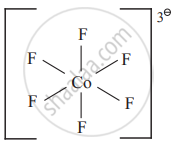Advertisements
Advertisements
प्रश्न
Explain the formation of [CoF6]3Θ complex with respect to
- Hybridisation
- Magnetic properties
- Inner/outer complex
- Geometry
उत्तर
Formation of [CoF6]3Θ ion:
- Oxidation state of central metal Co is +3.
- Valence shell electronic configuration of Co3⊕ is

- Six fluoride FΘ ligands, thus the number of vacant metal ion orbitals required for bonding with ligands would be six.
- Complex is high spin, which means the pairing of electrons will not take place prior to hybridisation. The electronic configuration would remain the same as in the free state shown above.
- Six orbitals available for hybridisation are one 4s, three 4p, two of 4d orbitals.

- Six metal orbitals after bonding with six FΘ ligands led to the sp3d2 hybridization.
- Six vacant sp3d2 hybrid orbitals of Co3+ overlap with six orbitals of fluoride forming Co-F coordinate bonds.
- Configuration after complex formation.

- The complex is octahedral and has four unpaired electrons and hence, is paramagnetic.

APPEARS IN
संबंधित प्रश्न
Answer in brief.
What are the high-spin and low-spin complexes?
Answer in brief.
[CoCl4]2- is a tetrahedral complex. Draw its box orbital diagram. State which orbitals participate in hybridization.
Answer in brief.
[CoCl4]2- is a tetrahedral complex. Draw its box orbital diagram. State which orbitals participate in hybridization.
Answer in brief.
With the help of the crystal field, the energy-level diagram explains why the complex [Cr(en)3]3⊕ is coloured.
Answer the following question.
Give valence bond description for the bonding in the complex [VCl4]-. Draw box diagrams for the free metal ion. Which hybrid orbitals are used by the metal? State the number of unpaired electrons.
Answer the following question.
Draw a qualitatively energy-level diagram showing d-orbital splitting in the octahedral environment. Predict the number of unpaired electrons in the complex [Fe(CN)6]4-. Is the complex diamagnetic or paramagnetic? Is it coloured? Explain.
Answer the following with respect to [CoF6]3– ion
- Type of hybridization
- Number of unpaired electrons
- Geometry of complex ion
- Magnetic property
Identify the number of donor groups present in EDTA.
The number of unpaired electrons in the complex ion [CoF6]3− is ____________.
The number of unpaired electrons in the complex ion [NiCl4]2− is ____________.
What is the type of magnetic behavior and geometry respectively in Cuproammonium sulphate (Atomic number of Cu = 29)?
Identify the increasing order of effective magnetic moment of the following elements in their +2 oxidation state.
[Fe (Z = 26), Co (Z = 27), Ni (Z = 28), Cu (Z = 29)]
Which of the following types of square planar complexes can show geometrical isomerism [M = metal, a, b, = monodentate ligand]?
A compound forms hcp structure. What is the number of (a) octahedral voids, (b) tetrahedral voids, (c) total voids formed in 0.2 mol of the compound?
Octahedral complex have ______ hybridisation.
Give the limitations of VBT.
A compound forms hexagonal close packed (hcp) structure. What is the number of (i) Octahedral voids, (ii) Tetrahedral voids, (iii) Total voids formed in 0.7 mol of it.
Mention the type of hybridization in [Co(NH3)6]3+ complex.
Mention the number of unpaired electrons and geometry of the following complex:
\[\ce{[Ni(Cl)4]^{2-}}\]
Mention the number of unpaired electrons and geometry of the following complex:
\[\ce{[Ni(CN)4]^2-}\]
